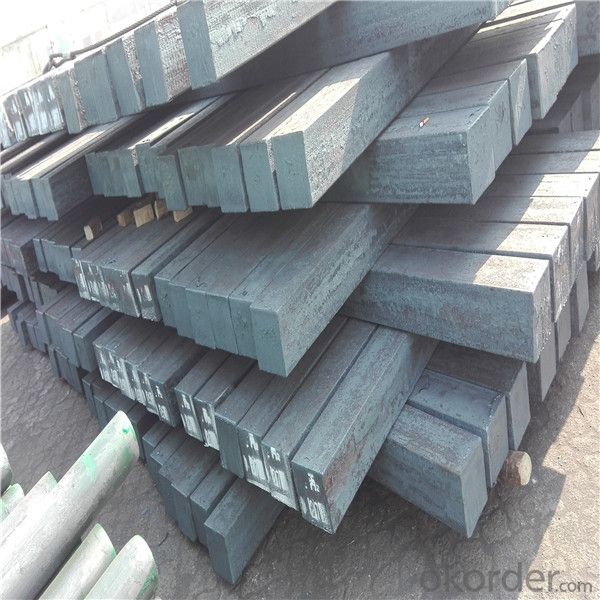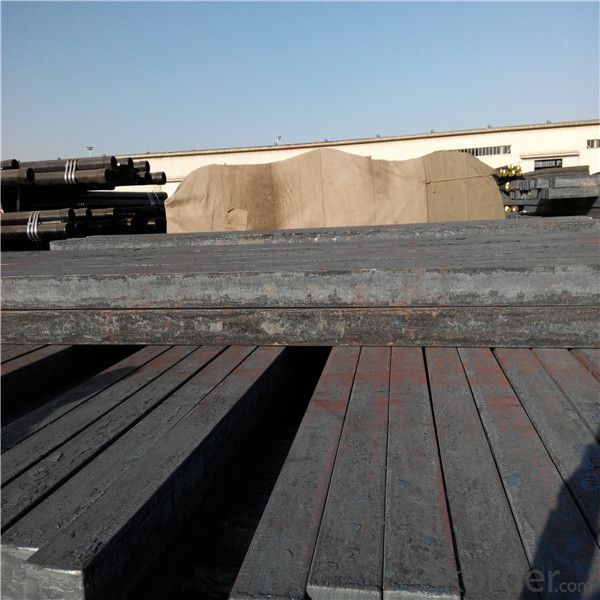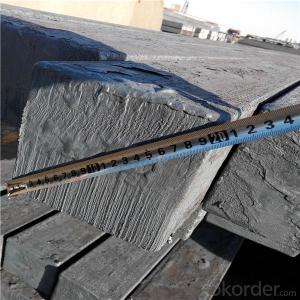Mild steel billet for sale low price made in china
- Loading Port:
- China main port
- Payment Terms:
- TT OR LC
- Min Order Qty:
- 1000 m.t.
- Supply Capability:
- 15542 m.t./month
OKorder Service Pledge
OKorder Financial Service
You Might Also Like
Item specifice
Steel billet :
Steel billet(ingot) by cogging or breakdown of semi-finished products, is the raw material of all kinds of steel mill. Billet section of square, round, flat, rectangular
and abnormity of several kinds of, mainly related to the shape of rolled products.
Gade:
Standard | C(%) | Mn(%) | S(%) | P(%) | Si(%) |
Q195 | ≤0.12 | ≤0.50 | ≤0.040 | ≤0.035 | ≤0.30 |
Q235 | ≤0.20 | ≤1.40 | ≤0.045 | ≤0.045 | ≤0.35 |
Q275 | ≤0.22 | ≤1.50 | ≤0.045 | ≤0.045 | ≤0.35 |
20MnSi | 0.17-0.25 | 1.2-1.6 | ≤ 0.050 | ≤ 0.050 | 0.40-0.80 |
3SP | 0.14-0.22 | 0.40-0.85 | ≤ 0.050 | ≤ 0.040 | 0.05-0.15 |
5SP | 0.28-0.37 | 0.50-1.00 | ≤ 0.050 | ≤ 0.040 | 0.15-0.30 |




Other Specifications
Squar Tolerance: ±4
Length Tolerance: +100mm
Romboidity/Difference Diagonals: no more than 0.7%
Camber: no more than 1.5%(%)
Twist: no more than 3 degrees per 1 meter length
Our Advantage
* Professional Personnel of Steel Trading
* Strong Steel Industry Background
* Conveniently Geographic Location
Our Commitment
* Sincere, Practical, Efficient and Developing
* High Quality Steel Production
* Competitive Price and Timely Delivery
Packing :
Within 30 days
1.Standard export package
2.In bundles with steel strips
3.As the requirements of the customers
FAQ:
Q: How to get quotation?
A: When we receive your detailed enquiry, we will set the best price based on standard,
steel grade, outer diameter, wall thickness, quantity, country.
And we will send quotation to your mailbox.
Q:How to guarantee the quality of the products?
A:We have established the international advanced quality management system,every link from raw material
to final product we have strict quality test;We resolutely put an end to unqualified products flowing into the market.
At the same time, we will provide necessary follow-up service assurance.
Q:How long can we receive the product after purchase?
A :In the purchase of product within three working days, We will arrange the factory delivery as soon as possible.
The pecific time of receiving is related to the state and position of customers.
- Q:How are steel billets used in the manufacturing of packaging materials?
- Steel billets are often used in the manufacturing of packaging materials due to their durability and strength. These billets, which are essentially semi-finished steel products, serve as the raw material for various packaging products such as cans, drums, and containers. To manufacture packaging materials, the steel billets are first heated to a specific temperature, allowing them to be easily shaped and molded. They are then passed through a series of rolling mills, where they are flattened and elongated into the desired shape and size. This process, known as hot rolling, helps to improve the mechanical properties of the steel and increase its strength. Once the steel billets have been transformed into the desired shape, they are further processed and coated to enhance their corrosion resistance and provide a smooth surface finish. This coating can be a layer of tin, lacquer, or polymer, depending on the specific packaging requirements. The finished steel packaging materials offer a wide range of advantages. They are strong and durable, providing excellent protection to the products they contain. They are also impermeable to moisture, gases, and light, ensuring the preservation and freshness of the packaged goods. Additionally, steel packaging materials are 100% recyclable, making them an environmentally friendly choice for packaging solutions. In summary, steel billets are an essential component in the manufacturing of packaging materials. By undergoing various shaping, rolling, and coating processes, these billets are transformed into strong and durable packaging products that provide excellent protection and preservation for a wide range of goods.
- Q:How do steel billets differ from steel ingots?
- Steel billets and steel ingots are both intermediate forms of steel that are produced during the steel manufacturing process. However, there are some key differences between them. Firstly, the shape and size of steel billets and steel ingots differ. Steel billets are typically square or rectangular in shape, with a cross-sectional area of around 36 square inches. They are long and slender, usually measuring around 6 to 12 inches in width and 1 to 12 feet in length. On the other hand, steel ingots are generally larger and more irregular in shape. They can be cylindrical, rectangular, or even a combination of shapes, depending on the production method used. Steel ingots are usually much larger than billets, with a typical weight ranging from several tons to over 100 tons. Secondly, the production process for steel billets and steel ingots also differs. Steel billets are usually created through continuous casting, where molten steel is poured into a mold and then cooled and solidified to form a billet. This process allows for a more controlled and uniform shape, size, and composition of the billet. Steel ingots, on the other hand, are typically produced through ingot casting, where molten steel is poured into a large mold and left to solidify. This method is often used for larger steel ingots and allows for a more flexible and adaptable production process. Lastly, the purpose and usage of steel billets and steel ingots also vary. Steel billets are commonly used as raw material for further processing and shaping into various steel products, such as bars, rods, wire, and tubes. They serve as a starting point for the manufacturing of finished steel products. Steel ingots, on the other hand, are usually used for more specialized applications, such as the production of large steel components, forgings, or specialty alloys. Their larger size and irregular shape make them suitable for such demanding applications. In summary, steel billets and steel ingots differ in terms of their shape, size, production process, and usage. While steel billets are slender, square or rectangular in shape, and used as raw material for further processing, steel ingots are larger, more irregularly shaped, and often used for specialized applications.
- Q:How are steel billets used in the production of molds?
- Steel billets are an important component in the production of molds as they serve as the raw material for creating the mold itself. The process begins by selecting a suitable steel billet, which is typically a solid rectangular or square piece of steel. Once the steel billet is chosen, it undergoes a series of manufacturing processes to transform it into a mold. Firstly, the billet is heated to a high temperature, known as the forging temperature, which makes it malleable and easier to work with. This heating process is crucial as it allows the steel to be shaped and molded into the desired form. After heating, the steel billet is subjected to a variety of shaping techniques such as rolling, pressing, or hammering. These methods help to shape the steel into the desired mold design, which could be a simple or complex shape depending on the application. Once the desired shape is achieved, the steel billet is cooled down and undergoes further processes such as machining, grinding, and polishing to refine the mold's surface finish and dimensional accuracy. This ensures that the mold is precise and capable of producing high-quality products. Overall, steel billets are used in the production of molds as the base material that is shaped and refined to create a customized mold design. These molds are then used in various industries such as automotive, aerospace, and manufacturing to produce a wide range of products.
- Q:What are the common surface defects found in steel billets?
- Common surface defects found in steel billets include: 1. Scale: Scale is a type of oxide layer that forms on the surface of steel due to exposure to high temperatures during the manufacturing process. It appears as a flaky, rough layer and can affect the quality of the steel. 2. Surface cracks: Cracks can form on the surface of steel billets due to various reasons such as improper cooling, improper handling, or excessive stress during the manufacturing process. These cracks can weaken the steel and reduce its structural integrity. 3. Inclusions: Inclusions are non-metallic impurities that can be present in the steel billet. These impurities can be in the form of oxides, sulfides, or other foreign materials. Inclusions can cause weak spots in the steel, leading to potential failures or defects in the final product. 4. Decarburization: Decarburization is the loss of carbon content from the surface of the steel billet. It occurs when the steel is exposed to high temperatures for an extended period or inadequate protective atmospheres during the manufacturing process. Decarburization can reduce the hardness and strength of the steel. 5. Surface roughness: Steel billets may have surface irregularities or roughness due to improper processing or handling. This can affect the surface finish and overall appearance of the billet. 6. Roll marks: Roll marks are impressions or patterns left on the surface of the steel billet during the rolling process. These marks can be caused by issues with the rolling mill equipment, such as improper alignment or worn-out rolls. 7. Lamination: Lamination refers to the presence of layers or separations within the steel billet. This defect can occur due to improper solidification during the casting process, inadequate temperature control, or the presence of impurities. It is important to detect and address these surface defects in steel billets to ensure the production of high-quality steel products. Various inspection techniques, such as visual inspection, ultrasonic testing, magnetic particle testing, and eddy current testing, can be used to identify and classify these defects.
- Q:How do steel billets contribute to the overall corrosion protection of a structure?
- Steel billets, which are semi-finished steel products, play a significant role in contributing to the overall corrosion protection of a structure. They contribute to corrosion protection in several ways: 1. High-quality steel composition: Steel billets are manufactured using high-quality steel that consists of various alloying elements, such as chromium, nickel, and molybdenum. These alloying elements enhance the corrosion resistance of the steel, making it less susceptible to rust and corrosion. 2. Protective coating: Steel billets are often coated with protective layers, such as zinc or epoxy coatings. These coatings act as a barrier between the steel surface and the external environment, preventing moisture, oxygen, and other corrosive substances from reaching the steel and causing corrosion. 3. Durability and strength: Steel billets are known for their high strength and durability. When used in the construction of a structure, they provide a strong foundation and structural support. This strength and durability minimize the chances of structural damage and corrosion, ensuring the longevity and stability of the structure. 4. Weldability: Steel billets are highly weldable, allowing for easy and efficient joining of steel components during construction. Proper welding techniques and materials can further enhance the corrosion resistance of the structure by maintaining the integrity and continuity of the protective coatings. 5. Maintenance and repair: In case of any damage or corrosion on the structure, steel billets can be easily replaced or repaired. This ensures that the affected area can be fixed without compromising the overall integrity and corrosion protection of the structure. Regular maintenance and repair of steel billets contribute to the long-term corrosion protection of the entire structure. In summary, steel billets contribute to the overall corrosion protection of a structure through their high-quality composition, protective coatings, durability, weldability, and ease of maintenance and repair. By incorporating steel billets into construction projects, engineers and architects can ensure the longevity, safety, and corrosion resistance of structures in various environments.
- Q:How are steel billets used in the manufacturing of gears and bearings?
- Gears and bearings rely heavily on steel billets as a vital raw material during their manufacturing process. These billets, which are semi-finished steel products, are typically cast into rectangular or square shapes. They act as the starting point for producing different components utilized in gears and bearings. Regarding gears, steel billets are initially cut into smaller sections to create gear blanks or rough gear shapes. These blanks then undergo a series of operations, including forging, machining, and heat treatment. Forging involves shaping the gear blank using compressive forces, enhancing the mechanical properties of the steel and aligning the grain structure for increased strength. Subsequently, machining is employed to eliminate excess material, refine the shape, and form the gear teeth. Ultimately, heat treatment is applied to enhance the hardness, toughness, and wear resistance of the gear. Similarly, in bearing manufacturing, steel billets are transformed into various components such as inner and outer rings, balls or rollers, and cages. Initially, the billets are cut and shaped into rough rings, which are further processed through machining operations to attain the desired dimensions and precision. Often, the rings undergo heat treatment to enhance their hardness, improve surface finish, and increase resistance to wear and fatigue. The balls or rollers are also produced from steel billets using a similar process, while cages are typically fabricated separately using sheet metal. In summary, steel billets play a vital role in the manufacturing of gears and bearings. They serve as the foundational material, undergoing various shaping, machining, and heat treatment processes to create the final components with the required strength, durability, and precision. The quality of the steel billets used significantly impacts the performance and longevity of gears and bearings, thus making them an essential aspect of the entire manufacturing process.
- Q:What is the billet price in China today?
- In the short term is still the main shock, the domestic price rise compared to the previous 10 yuan / ton, the price is not the same in each region, so you still have to carefully check the price, from the upstream iron ore, domestic ore prices stabilize, without much change, with the real estate back to temperature. Building materials tend to be stable, the price is good to pick up the trend, the overall no big changes, specific to my steel network detailed inquiries, information here will be updated every day
- Q:How do steel billets contribute to the manufacturing of furniture?
- Steel billets are an essential raw material in the manufacturing of furniture as they are used to create sturdy and durable frames, legs, and supports. The billets are melted down and shaped into various forms, allowing furniture manufacturers to produce high-quality and robust pieces that can withstand heavy loads and regular use.
- Q:What are the different surface finishes available for stainless steel billets?
- There are several surface finishes available for stainless steel billets, depending on the desired aesthetic appearance and functional requirements. Some of the most common surface finishes for stainless steel billets include: 1. Mill Finish: This is the standard finish produced by the steel mill during the manufacturing process. It has a dull appearance with visible oxidation marks and can vary in smoothness. 2. Hot Rolled: This finish is achieved by heating the stainless steel billet and then rolling it through a series of rollers. It results in a rougher surface with visible scale and a characteristic orange peel texture. 3. Cold Rolled: This finish is obtained by subjecting the stainless steel billet to cold rolling, which reduces its thickness and improves its surface smoothness. It has a slightly reflective appearance and is often used for applications requiring a smooth finish. 4. Brushed Finish: Also known as satin finish, this surface finish is achieved by mechanically brushing the stainless steel billet with abrasive materials. It creates a consistent linear pattern, giving the steel a matte appearance. 5. Polished Finish: This finish involves polishing the stainless steel billet using abrasives to create a smooth and reflective surface. The level of polish can vary from a low-gloss satin finish to a mirror-like, highly reflective finish. 6. Bead Blasted Finish: In this finish, the stainless steel billet is bombarded with tiny glass or ceramic beads under high pressure, which creates a uniform matte texture. It is commonly used for architectural and decorative applications. 7. Electropolished Finish: This surface finish is achieved by immersing the stainless steel billet in an electrolyte bath and applying an electric current. It removes a thin layer of material, resulting in a smooth, reflective surface with improved corrosion resistance. These are just a few examples of the different surface finishes available for stainless steel billets. Each finish has its own unique characteristics and is chosen based on the specific requirements of the application, such as aesthetics, corrosion resistance, and ease of cleaning.
- Q:Can steel billets be used in the production of consumer electronics?
- No, steel billets are primarily used in the production of construction materials and machinery, rather than consumer electronics which typically require more specialized materials such as semiconductors, plastics, and alloys.
1. Manufacturer Overview |
|
|---|---|
| Location | |
| Year Established | |
| Annual Output Value | |
| Main Markets | |
| Company Certifications | |
2. Manufacturer Certificates |
|
|---|---|
| a) Certification Name | |
| Range | |
| Reference | |
| Validity Period | |
3. Manufacturer Capability |
|
|---|---|
| a)Trade Capacity | |
| Nearest Port | |
| Export Percentage | |
| No.of Employees in Trade Department | |
| Language Spoken: | |
| b)Factory Information | |
| Factory Size: | |
| No. of Production Lines | |
| Contract Manufacturing | |
| Product Price Range | |
Send your message to us
Mild steel billet for sale low price made in china
- Loading Port:
- China main port
- Payment Terms:
- TT OR LC
- Min Order Qty:
- 1000 m.t.
- Supply Capability:
- 15542 m.t./month
OKorder Service Pledge
OKorder Financial Service
Similar products
New products
Hot products
Hot Searches
Related keywords






























